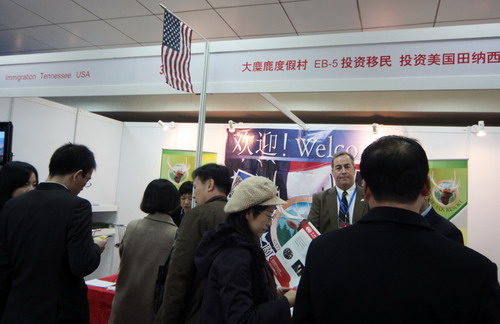US
Brooklyn offers a 'green' way
By Kelly Chung Dawson (China Daily)
Updated: 2010-09-10 10:59
 |
Large Medium Small |
|
 US business people take advantage of the EB-5 program to attract Chinese investors at a real estate exhibition in Beijing. Wu Changqing/For China Daily |
The US Bureau of Citizenship and Immigration Services said 10,000 green cards are approved by the government each year under the EB-5 program and distributed through about 100 regional centers around the country.
Investors are required to contribute $500,000 with no guarantee of a return or green card unless the project successfully creates 10 full-time permanent jobs for American residents and generates money over five to six years.
The Brooklyn Navy Yard expansion will create 2,900 jobs for New Yorkers, said George Olson, managing principal of the New York City Regional Center (NYCRC).
The project has already netted over 200 investors, raising around $105 million.
"Everyone makes out," Olson said. "People who want to come to this country, who want to invest in this country, put their money at risk to create jobs. It's a great idea.
"This project will ensure that 2,900 families will have food on the table."
The expansion is the first major project in the New York area to attempt fundraising through immigration investment on such a large scale. NYCRC was established in 2008 and was the nation's 32nd EB-5 regional center.
Expansion plans for the Brooklyn Navy Yard include a green manufacturing center, the city's first building-mounted wind turbine and an expansion of Steiner Studios, a company responsible for major Hollywood blockbusters such as Sex and the City 1 and 2, and Enchanted.
The expansion will create construction jobs and permanent positions in TV and film production, Douglas C. Steiner, its chairman, said.
"We think the EB-5 program is a perfect fit for this project, because it's such a job generator," Steiner said. "It's a great program because it repatriates money from overseas.
"We have a tremendous trade imbalance, and it brings some of that money back here to create American jobs."
Investors are from all over the world, including China, South Korea and Venezuela, Olson said. South Koreans have been participating for six or seven years, and China has become a larger portion of the investment pool over the past three to four years, Olson said.
The US Citizenship and Immigration Services said that of the 2,688 green cards distributed through the EB-5 program to Asian investors last year, 1,828 were to the Chinese.
Gary Stern, from Chuhak & Tecson, a Chicago law firm that specializes in EB-5 immigration, believes the increase in Chinese applications is both a reflection of China's increasing wealth and more open government policies about allowing money to leave the country.
Some critics have dismissed the program as simply selling green cards, but there are major risks involved that complicate the process, Olson said.
"People have lost money at this, and there are two major factors that one has to consider," he said.
"Investors have to put their money into areas that specifically have high unemployment rates, around 15 percent, or 150 percent of the national average.
"That makes the investment riskier, and the investor also must ensure that 10 jobs are ultimately created for American residents.
"That's two hurdles to get over."
Olsen said it's a "disservice" to a great program to think that these investors are buying green cards.
"These investors are putting hard-earned money at risk in a way that benefits everyone," he said.
China Daily